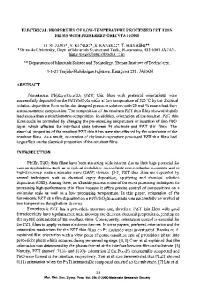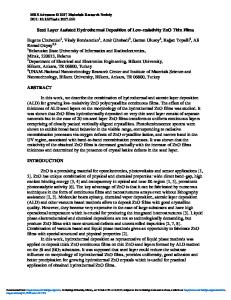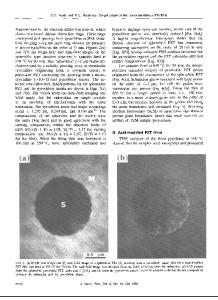Effect of seed layer with low lead content on electrical properties of PZT thin films
- PDF / 904,883 Bytes
- 10 Pages / 584.957 x 782.986 pts Page_size
- 71 Downloads / 360 Views
Ekaterina Guschina Division of Solid State Physics, Ioffe Institute, Saint-Petersburg 194021, Russian Federation
Nina Zaitseva Division of Physics of Dielectric and Semiconductors, Ioffe Institute, Saint-Petersburg 194021, Russian Federation
Sergey Pavlov Department of Diagnostic of Materials and Structures of SSE, Ioffe Institute, Saint-Petersburg 194021, Russian Federation
Dmitry Seregin, Konstantin Vorotilov, and Alexander Sigov
SEC “Technological Center,” Moscow Technological University (MIREA), Moscow 119454, Russian Federation (Received 20 February 2017; accepted 5 April 2017)
Two-step crystallization process based on a low-Pb-content seed layer is proposed to form PZT films by the chemical solution deposition. The first crystallization step was performed after the deposition from precursor solutions with 0 and 5 wt% Pb excess, which provides a low nucleation rate and the strong perovskite (111) orientation. The bulk film was obtained from solutions with a 30 wt% Pb excess, which ensures a high growth rate and eliminates formation of pyrochlore residuals. Some films with a fixed Pb excess were prepared for comparison. It is shown that the low-Pb-content seed layer can sufficiently enhance the texture of perovskite (111) grains thus providing the highest polarization magnitudes as compared to films prepared with the fixed Pb content. The lead content and the crystallization of the seed layer are found to affect the grainboundary conduction, which, in turn, influences the polarization dependence of transient currents.
I. INTRODUCTION
Thin-film lead zirconate titanate Pb(Zr,Ti)O3 (PZT) is a widely used ferroelectric (Fe) material for applications in various integrated ferroelectric devices, including nonvolatile ferroelectric random access memory (FeRAM), field-effect transistors, microelectromechanical systems (MEMS), pyroelectric sensors, transducers, energy harvesting devices, etc. This is due to its relatively low crystallization temperature, high spontaneous polarization, and large piezoelectric coefficients.1–8 Despite the attempts on replacing PZT and other lead-containing ferroelectrics with lead-free ferroelectrics due to the health hazard issues, there presently are no alternative candidates with the same properties.9,10 Moreover, it seems that this discussion is more vital for ceramic industry than for semiconductor manufacturing technology because the latter has advanced utilization techniques in its arsenal.
Contributing Editor: Paul Muralt a) Address all correspondence to this author. e-mail: [email protected] This paper has been selected as an Invited Feature Paper. DOI: 10.1557/jmr.2017.156
The integration of PZT in the FeRAM technology is a rather difficult task due to the high diffusivity and interaction of all elements of the heterostructure based on PZT and Si, lead oxide volatility, challenges in etching, barriers, etc.11 The integration of other perovskite ferroelectrics, e.g., strontium bismuth tantalite (SBT), meets the same problems and in addition they have higher crystallization points.12
Data Loading...










